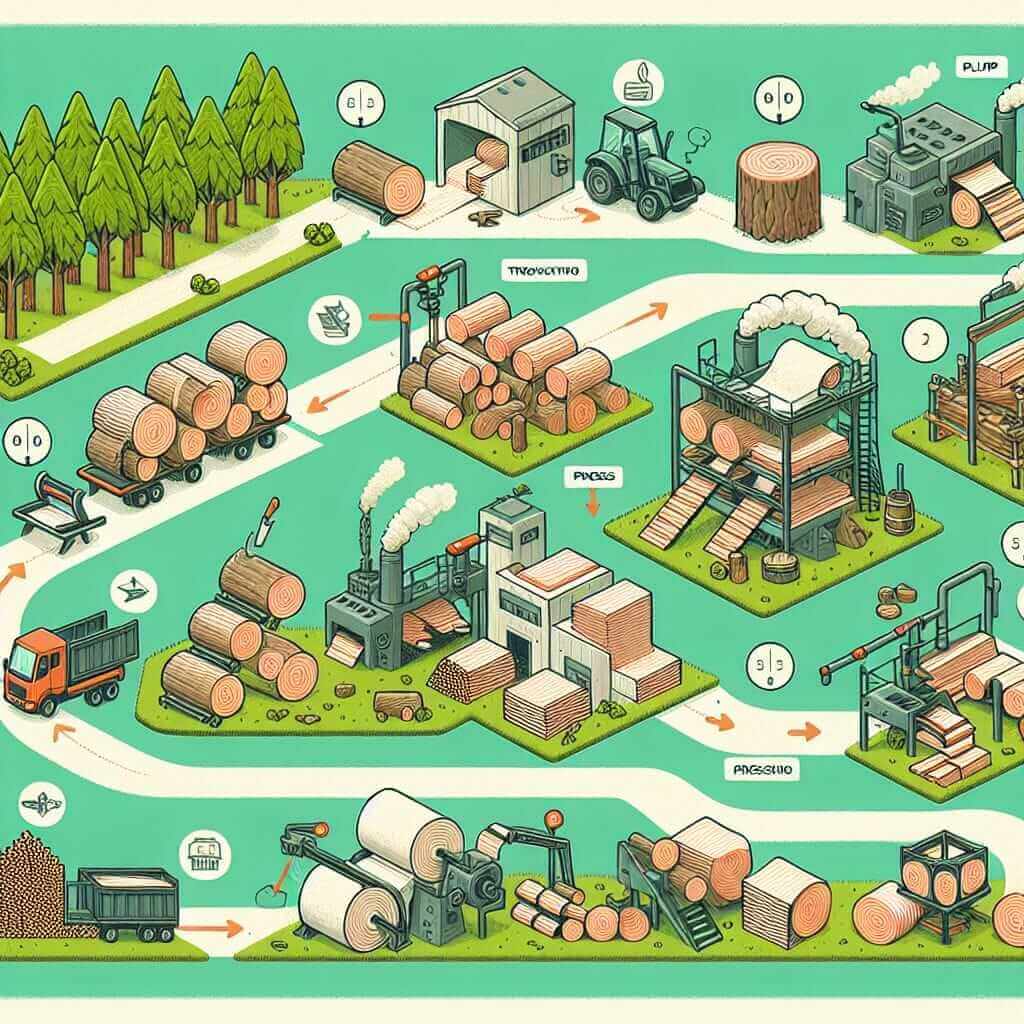The IELTS Writing Task 1 often presents candidates with a visual representation of a process, and one common theme is the paper production process from wood. Understanding this process and being equipped with the right vocabulary and grammar is crucial for achieving a high band score. This article will guide you through analyzing a sample process diagram, crafting a well-structured response, and provide essential vocabulary and tips to excel in this IELTS task.
Understanding the Task: IELTS Writing Task 1 Process Diagram
In the IELTS Writing Task 1, you may be asked to describe a process presented as a diagram. This diagram could illustrate anything from a manufacturing process to a natural phenomenon. Your task is to describe this process accurately, clearly, and coherently in English.
Common Topics Related to “Paper Production Process from Wood”:
- Paper Manufacturing Process: This focuses on the industrial steps involved in converting wood into paper.
- Wood Pulp Production: This delves deeper into the specific stage of turning wood into pulp, a key intermediate material.
- Environmental Impact of Paper Production: This topic explores the ecological consequences of paper manufacturing, including deforestation and water pollution.
Sample Task: Paper Production from Wood
Let’s look at a sample task:
The diagram below illustrates the process of producing paper from wood.
Summarize the information by selecting and reporting the main features, and make comparisons where relevant.

Analyzing the Diagram
Before writing, carefully analyze the provided diagram.
- Identify the Starting and Ending Points: Where does the process begin, and where does it end?
- Break Down the Process into Stages: How many distinct steps are there? What happens at each step?
- Note the Materials and Equipment: What materials are used? What equipment is involved in each stage?
Sample Answer
The diagram illustrates the complex process of transforming wood into paper, involving several key stages.
Initially, logs are harvested and transported to a paper mill, where they undergo debarking. The debarked logs are then fed into a chipper, which reduces them into smaller wood chips. These chips are subsequently screened to ensure uniformity in size.
The screened chips proceed to the pulping stage, where they are mixed with chemicals and water in a digester. This process breaks down the wood chips into cellulose fibers, forming a slurry known as pulp. The pulp undergoes washing and bleaching to remove impurities and enhance its brightness.
Next, the refined pulp is fed into a paper machine. It first passes through a headbox, which distributes the pulp evenly onto a moving wire mesh. As the water drains away, the pulp fibers bond together, forming a continuous sheet of paper.
This wet paper sheet then travels through a series of rollers that press out the remaining water and further compact the fibers. The paper sheet is then dried by passing it over heated rollers. Finally, the dried paper is wound onto large rolls, ready for further processing or cutting into sheets.
Word Count: 173 words
Key Vocabulary and Grammar for Describing Processes
Vocabulary:
- Harvesting: The process of cutting down trees or crops.
- Debarking: Removing the bark from a tree trunk.
- Chipper: A machine that cuts wood into chips.
- Screening: Sorting materials based on size.
- Pulping: The process of converting wood chips into pulp.
- Digester: A large vessel used for cooking wood chips under high pressure.
- Cellulose fibers: The main structural component of plants, used to make paper.
- Bleaching: The process of whitening pulp.
- Headbox: A device that distributes pulp evenly onto a paper machine.
- Wire mesh: A fine metal mesh used to drain water from pulp.
- Rollers: Cylindrical objects used for pressing or transporting materials.
- Drying: The process of removing moisture.
- Winding: The process of wrapping something around a spool or core.
Grammar:
- Passive Voice: The passive voice is often used when describing processes because the focus is on the action being done rather than the agent performing the action.
- Example: “The logs are transported to a paper mill.”
- Sequencing Words: Use sequencing words (first, next, then, after that, finally) to clearly show the order of steps in the process.
- Present Simple Tense: The present simple tense is generally used to describe the steps in a process.
Tips for Achieving a Band 7+ Score
- Paraphrase the Question: Don’t copy directly from the question; use synonyms and different sentence structures to demonstrate your vocabulary and grammar range.
- Focus on the Main Features: Don’t try to describe every single detail. Highlight the most important steps and components of the process.
- Compare and Contrast: If there are multiple stages or elements, make comparisons where relevant to demonstrate your understanding of the relationships between them.
- Use a Range of Vocabulary: Show off your knowledge of topic-specific vocabulary (like the words listed above) to enhance your description.
- Accurate Grammar: Use a variety of grammatical structures, including complex sentences, but ensure your grammar is accurate throughout.
- Proofread Carefully: Always allow time to check your work for any errors in spelling, grammar, or punctuation.
By following these tips and practicing regularly, you can approach the IELTS Writing Task 1 process diagram with confidence and achieve a high band score!